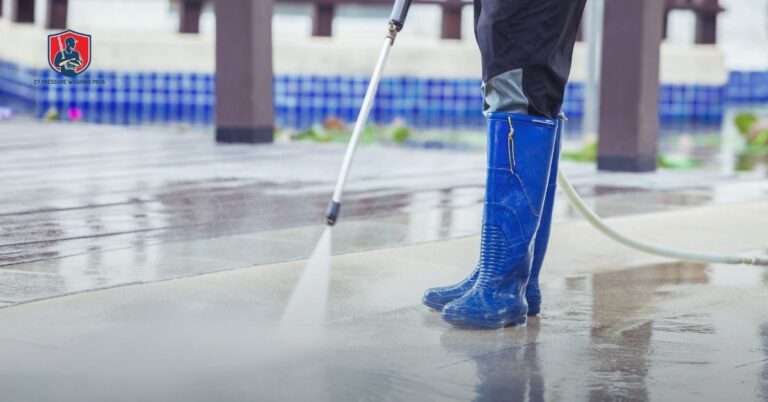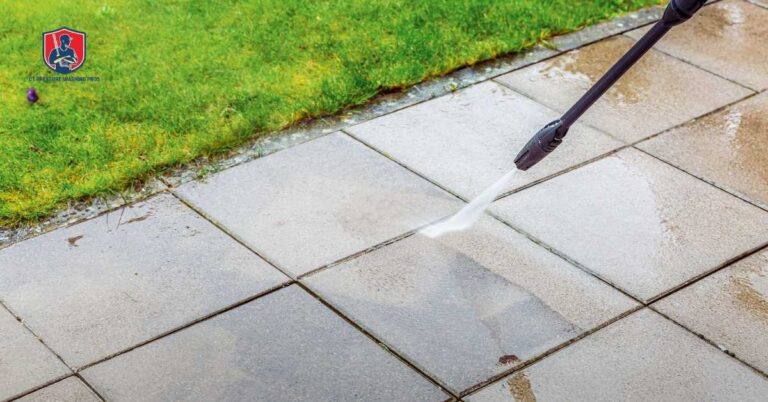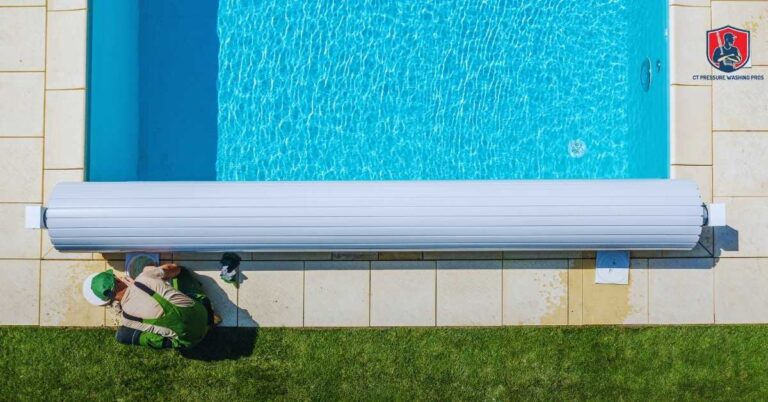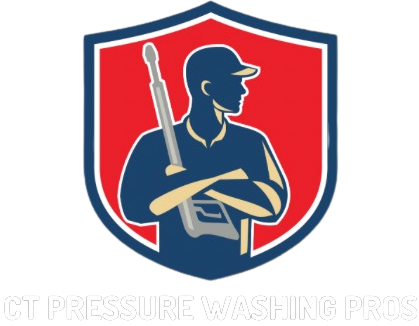Fall doesn’t just mean cooler air and colorful leaves—it’s also the perfect time to clean your home’s exterior before winter hits. Leaves, dirt, mildew, and grime pile up fast this time of year. If left alone, that mess can freeze, stain, or even damage your surfaces once snow and ice move in.
Pressure washing in the fall clears away all the buildup that summer left behind. It helps your siding, deck, driveway, and gutters stay in better shape through freezing weather—and makes your place look sharp before the holidays.
Let me explain: a quick fall cleanup can save you from bigger repairs later. This guide gives you simple, effective fall pressure washing tips to get your home ready for winter, without wasting time or doing things the hard way.
So read on. Your home’s winter prep starts here.
Table of Contents
Why Fall Pressure Washing Is Important Before Winter
Fall might feel like the end of the season, but it’s your last real shot to protect your home before winter locks everything down. Dirt and grime aren’t just ugly—they hold moisture, and moisture becomes damaged when it freezes. A pressure washer eliminates that risk quickly and sets the stage for other tasks, such as sealing, painting, or simply enjoying a clean space.
Here’s why fall pressure washing matters:
- Protects surfaces from winter moisture damage
Freezing temps can crack paint, wood, and concrete if there’s trapped moisture. Pressure washing clears that out early.
- Removes fall debris, mold, and organic buildup
Wet leaves and leftover summer grime can stain surfaces or grow mold that spreads in winter’s damp air.
- Prepares your home for sealing, painting, or decorating
Clean surfaces bond better with sealants and paints, and your holiday lights will look better on a fresh background.
- Reduces the risk of slippery walkways during winter
A layer of algae or wet leaf stains on concrete can turn into an ice rink overnight. Washing it now lowers the risk.
- Increases curb appeal before the holidays.
Whether you’re hosting or selling, a clean home exterior looks better and shows you take care of your place.
Fall Pressure Washing Tips
Fall doesn’t wait. One week it’s colorful leaves, the next it’s frozen steps and snow piling up. If you want your home’s exterior to survive the season without staining, cracking, or slipping hazards, now’s the time to act. These fall pressure washing tips will help you clean smarter, not harder, and make sure your home’s ready for winter.

Tip #1: Start Early in the Fall Season
Timing is everything. Once the temperature dips below 40°F, water becomes a risk instead of a solution. Start early while the weather is still mild and surfaces can dry properly. You’ll avoid freezing mishaps, cracked siding, and damaged equipment. Look for a dry stretch of at least two days to wash and let everything cure.
Tip #2: Clear Leaves and Debris Before You Start
Leaves might seem harmless, but when wet, they stain concrete and clog your washer. Before you pull the trigger, sweep, rake, or blow away all the loose material. This gives your pressure washer direct access to the grime, stopping you from pushing soggy debris into corners or cracks.
Tip #3: Use a Pressure Washer-Safe Detergent for Mold and Algae
Mold and algae thrive in damp fall conditions, especially on shaded siding and decks. A quality exterior detergent breaks them down faster than water alone. Spray it on, let it sit for 5–10 minutes (don’t rush this), then rinse it off. That dwell time allows the cleaner to do its job without the need for high pressure that could damage surfaces.
Tip #4: Pressure Wash Siding from Top to Bottom
Always start high and work your way down. This prevents dirty water from streaking clean spots and avoids water pushing up under the siding. Use a 25° or 40° nozzle for safe, wide coverage, and stay about a foot away from the surface to avoid etching or damage. Think of it like washing a car—gentle but thorough.
Tip #5: Focus on Driveways and Walkways
These areas take a beating from falling leaves, tire marks, and foot traffic. Wet organic matter can leave black stains and, if ignored, create slippery patches that freeze into ice. Pressure washing these paths now makes them safer and cleaner through the cold months, and easier to shovel or de-ice later.
Tip #6: Clean Gutters and Fascia Boards
Gutters stuffed with leaves don’t drain—they overflow. That overflow can freeze, form icicles, or cause water damage to your roof and siding. Use a gutter attachment or a low-pressure setting to rinse them clean. While you’re up there, spray off the fascia boards, where dirt and mildew often collect unnoticed.
Tip #7: Don’t Forget Decks, Patios, and Stairs
Wood, composite, or concrete—every surface benefits from a fall wash. Mold and moss on stairs or patio pavers can turn slick fast. A light pressure setting paired with the right cleaner will strip off dirt without stripping the surface. Once it’s clean and dry, you can apply a sealant or just enjoy how much better it looks.
Tip #8: Let All Surfaces Dry Fully Before Freezing Temps Hit
Washing the day before a freeze can backfire. Water trapped in cracks, wood grain, or porous concrete expands when it freezes, and that leads to split boards or surface cracks. Always check the weather. Give everything at least 24–48 hours of dry, above-freezing weather to fully dry out.
Tip #9: Inspect for Cracks or Damage After Washing
Once everything’s clean, you’ll spot what you couldn’t see before—cracks in concrete, wood rot, missing caulk, or loose trim. Now’s the time to fix it. Small repairs now are cheaper than emergency fixes after a snowstorm or ice buildup.
Tip #10: Consider Applying Sealants Post-Wash
If you’ve ever sealed a dirty surface, you know it just locks in the mess. After washing, your deck, pavers, or exposed concrete are ready for sealing. A water-repellent sealant helps prevent winter damage, makes snow removal easier, and keeps surfaces looking better longer. It’s an extra step that pays off all season.
So read on, you’re doing the smart thing by preparing now instead of scrambling when it’s already freezing out. Clean today, protect tomorrow.
Common Mistakes to Avoid with Fall Pressure Washing
Pressure washing in fall is smart—but it can backfire if you skip steps or rush the job. These common mistakes could cost you more than just time. Avoid them, and you’ll get better results without damaging your home or equipment.
#1. Washing Too Late in the Season
Waiting until it’s almost winter is a gamble. Cold temperatures can freeze water in cracks or create ice on surfaces before they dry. If the forecast dips below 40°F at night, hold off or risk frozen damage.
#2. Using Too Much Pressure on Fragile Surfaces
Blasting your siding or deck might feel satisfying, but it’s not worth the splinters, chips, or water damage. Use a wider nozzle and stay a safe distance away. Let the cleaner do the work, not brute force.
#3. Skipping Gutter Cleaning
Many people wash the siding and forget the gutters. Big mistake. Blocked gutters trap water, which freezes, overflows, or backs up into your roofline. Clean them while you’re already set up.
#4. Leaving Surfaces Wet Overnight in Freezing Zones
Washing late in the day? Bad move if temperatures drop at night. Wet wood or concrete can freeze, expand, and crack. Always give yourself enough daylight and drying time.
# 5. Not Prepping the Area Beforehand
Pressure washing without prep creates more mess than it fixes. Sweep, move furniture, cover outlets, and close windows. Five minutes of prep saves you an hour of cleanup.
So read on or go back to the tips section if you missed something. Avoiding these slip-ups means your home stays clean, safe, and winter-ready, with zero regrets.
Should You Hire a Pro for Fall Pressure Washing?
Doing it yourself can save money, sure—but it’s not always the best call. Pressure washing looks easy until you’re up on a ladder with freezing water spraying back at you. Some jobs just aren’t worth the risk or the hassle.
Let me explain: If your home is more than one story, has a lot of buildup, or you’re tight on time, hiring a pro might be the smarter move. They bring the right equipment, know how to handle tricky spots, and can finish the job faster with better results.
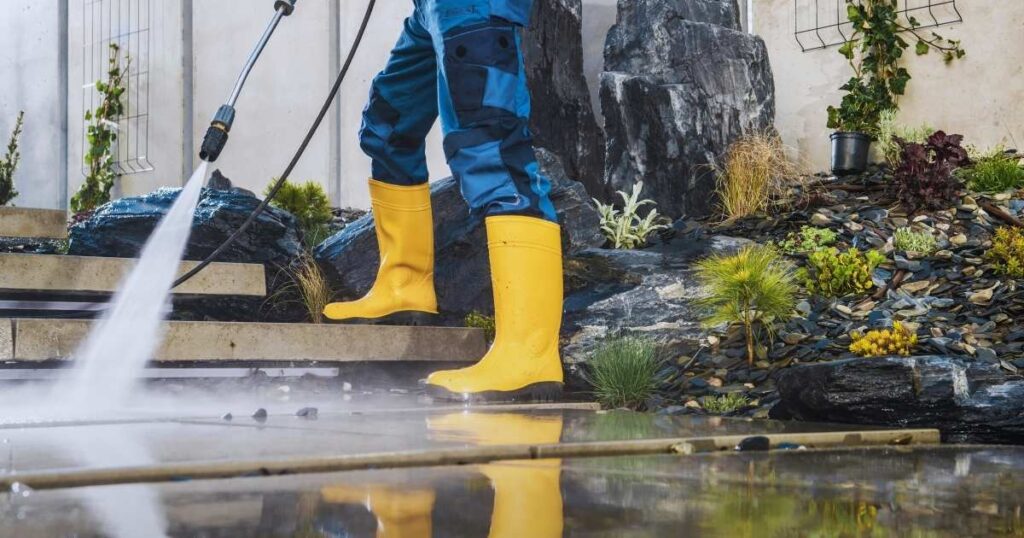
Here’s when it makes sense to call in help:
- You have a large home or multiple surfaces to clean
A full property wash can take all day, sometimes more. A crew can knock it out fast and evenly. - You need to clean high areas like second-story siding or gutters.
Ladders plus water equals risk. Professionals have the tools and safety gear to handle heights and angles without injury. - There’s heavy mold, mildew, or staining.g
Surface stains are one thing. Deep buildup is another. Pros use commercial cleaners and hot water systems to break it down without damaging the surface. - You want to seal or repaint after cleaning.
Professionals know how to prep surfaces properly so sealants stick and paint lasts longer. - You just don’t have time or energy.
Fall moves fast. Hiring out means one less chore on your list—and peace of mind that it’s done right.
Post-Wash Winter Preparation Checklist
You’ve done the cleaning—now it’s time to finish strong. These next steps protect your freshly washed surfaces and ensure your home stays in good shape through snow, ice, and freezing temperatures.
1. Seal Exposed Wood and Concrete
After pressure washing, decks, patios, and walkways are clean and absorbent. Sealing them now helps block moisture, prevent cracks, and extend their life through freeze-thaw cycles.
2. Store or Cover Outdoor Furniture and Decor
Don’t leave clean furniture or decorations exposed. Cover them or move them to storage to avoid rust, mold, or damage from snow and ice.
3. Blow Out and Drain Outdoor Hoses and Faucets
Disconnect, drain garden hoses, and shut off outdoor spigots if your area freezes. This prevents pipes from bursting and avoids costly repairs.
4. Check Gutters One More Time
Even after washing, late-falling leaves can sneak in. Do one final check to ensure gutters and downspouts are clear before the first snow hits.
5. Winterize Your Pressure Washer
Drain water from the pump, hoses, and wand. If it’s gas-powered, run the engine dry or add fuel stabilizer. Store it somewhere safe from freezing to keep it working for spring.
Conclusion
Pressure washing in the fall isn’t just a chore—it’s a smart move that protects what you’ve already invested in. Your home, like anything else you care about, needs regular upkeep. Taking the time now means fewer surprises later, fewer costly repairs, and a lot more peace of mind when the snow starts falling.
But here’s the bigger picture: a clean home isn’t just about looks or safety, it’s about control. Winter throws enough challenges your way. Having one less thing to worry about when ice hits your steps or water tries to sneak into your siding? That’s a win.
So whether you’re doing it yourself or hiring a pro, you’re not just washing off dirt—you’re getting ahead of winter. That’s the kind of prep work that pays off when it matters most.
Need help? Don’t wait for freezing weather to remind you what you missed. Get it done now, while it still makes a difference.


